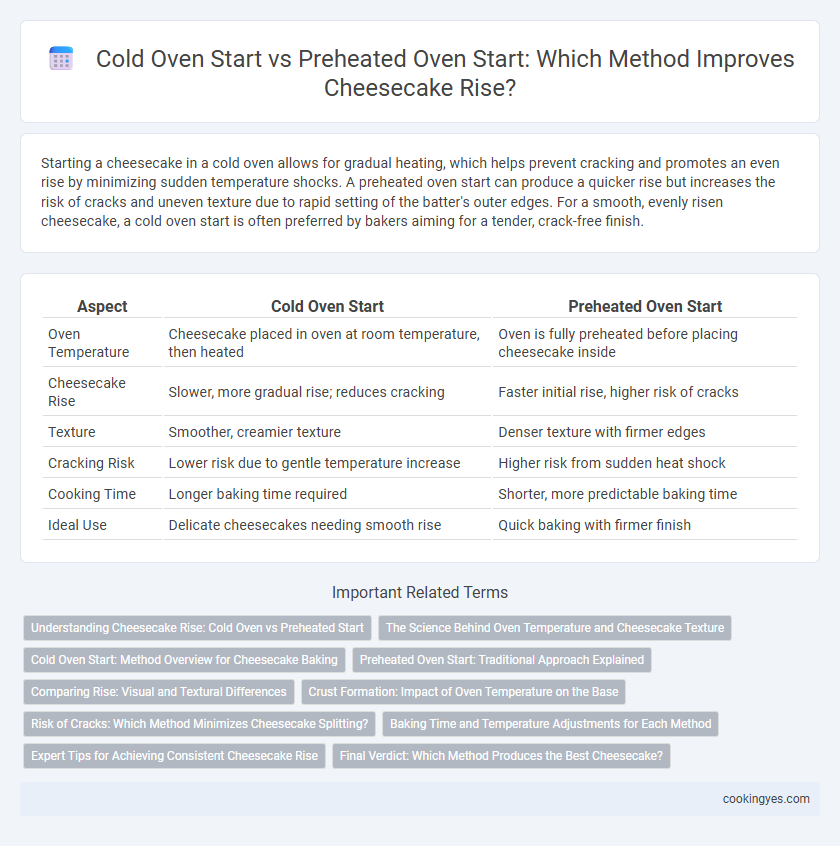Starting a cheesecake in a cold oven allows for gradual heating, which helps prevent cracking and promotes an even rise by minimizing sudden temperature shocks. A preheated oven start can produce a quicker rise but increases the risk of cracks and uneven texture due to rapid setting of the batter's outer edges. For a smooth, evenly risen cheesecake, a cold oven start is often preferred by bakers aiming for a tender, crack-free finish.
Table of Comparison
| Aspect | Cold Oven Start | Preheated Oven Start |
|---|---|---|
| Oven Temperature | Cheesecake placed in oven at room temperature, then heated | Oven is fully preheated before placing cheesecake inside |
| Cheesecake Rise | Slower, more gradual rise; reduces cracking | Faster initial rise, higher risk of cracks |
| Texture | Smoother, creamier texture | Denser texture with firmer edges |
| Cracking Risk | Lower risk due to gentle temperature increase | Higher risk from sudden heat shock |
| Cooking Time | Longer baking time required | Shorter, more predictable baking time |
| Ideal Use | Delicate cheesecakes needing smooth rise | Quick baking with firmer finish |
Understanding Cheesecake Rise: Cold Oven vs Preheated Start
Starting cheesecake in a cold oven allows gradual temperature increase, promoting even rise and reducing the risk of cracks by minimizing sudden expansion. A preheated oven start ensures immediate heat exposure, which can cause rapid initial rising but may lead to uneven baking and potential cracking on the surface. Understanding these effects helps optimize cheesecake texture by controlling oven temperature patterns during baking.
The Science Behind Oven Temperature and Cheesecake Texture
Starting a cheesecake in a cold oven allows gradual heating, minimizing temperature shock and promoting even rise by preventing cracks. A preheated oven exposes the batter to immediate high heat, which can cause rapid expansion and uneven texture due to sudden protein coagulation. The gradual temperature increase in a cold oven supports controlled coagulation of eggs and stabilization of the custard matrix, resulting in a creamier, smoother cheesecake texture.
Cold Oven Start: Method Overview for Cheesecake Baking
Cold oven start involves placing the cheesecake batter into an oven that has not been preheated, allowing the temperature to gradually increase as the cake bakes. This method promotes even heat distribution and reduces the risk of cracks by preventing sudden temperature fluctuations. Many bakers prefer cold oven start for achieving a smooth, dense texture and a consistent rise in cheesecakes.
Preheated Oven Start: Traditional Approach Explained
Preheated oven start is the traditional method for baking cheesecake, ensuring even heat distribution that promotes a consistent rise and smooth texture. This approach allows the batter to set quickly, reducing the risk of cracks and encouraging a stable, uniform structure. By entering a fully heated oven, the cheesecake gains a controlled environment that supports optimal oven spring and a tender, creamy finish.
Comparing Rise: Visual and Textural Differences
Starting a cheesecake in a cold oven results in a gentler, more gradual rise, producing a smooth, even surface with a dense, creamy texture. In contrast, using a preheated oven causes a rapid initial rise, often creating cracks and a puffier, aerated crumb. The cold oven method minimizes top splitting and promotes a consistent, velvety bite, while the preheated approach can yield a taller but less uniform cheesecake.
Crust Formation: Impact of Oven Temperature on the Base
Starting cheesecake baking in a cold oven leads to gradual temperature increase, which helps prevent sudden crust shrinkage and cracking, promoting a more even and firm base formation. A preheated oven causes immediate exposure to high heat, risking rapid crust setting and potential separation from the filling, which may result in uneven texture and compromised structural integrity of the cheesecake base. Optimal crust formation is achieved by balancing oven temperature and baking time to ensure a stable, cohesive foundation for the cheesecake rise.
Risk of Cracks: Which Method Minimizes Cheesecake Splitting?
Cold oven start minimizes the risk of cracks in cheesecake by allowing gradual temperature increase, reducing the stress on the batter and preventing rapid expansion that causes splitting. Preheated oven start exposes the cheesecake to sudden high heat, often leading to higher chances of surface cracks as the outer layer sets too quickly while the interior continues to expand. Therefore, a cold oven start method is generally recommended for achieving a smooth, crack-free cheesecake surface.
Baking Time and Temperature Adjustments for Each Method
Cold oven start for cheesecake involves placing the batter into an oven that heats gradually, requiring longer baking times at lower initial temperatures to ensure even rising and prevent cracking. Preheated oven start demands precise temperature adjustments, typically baking at a steady 325degF (163degC) for 50-60 minutes, which promotes a quicker set and consistent rise. Adjusting baking time by 10-15 minutes longer in the cold oven method compensates for the slow temperature ramp and enhances texture without overbaking.
Expert Tips for Achieving Consistent Cheesecake Rise
Starting a cheesecake in a cold oven allows gradual temperature increase, reducing the risk of cracks and promoting even rise, while a preheated oven offers faster baking but may cause uneven expansion. Expert tips emphasize using a water bath with either method to maintain consistent moisture and temperature, ensuring smooth texture and uniform height. Monitoring oven temperature accuracy and avoiding overmixing the batter also support a flawless, consistent cheesecake rise.
Final Verdict: Which Method Produces the Best Cheesecake?
Starting cheesecake baking in a cold oven promotes even heat distribution, preventing cracks and enabling a smooth, creamy texture, while preheated oven starts can cause rapid rising and potential over-browning. Studies and expert bakers often favor the cold oven method for achieving the perfect, velvety consistency and optimal rise. Therefore, the best cheesecake results typically come from beginning the baking process in a cold oven, ensuring uniform cooking and a flawless finish.
Cold Oven Start vs Preheated Oven Start for Cheesecake Rise Infographic

 cookingyes.com
cookingyes.com